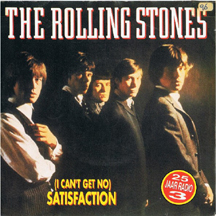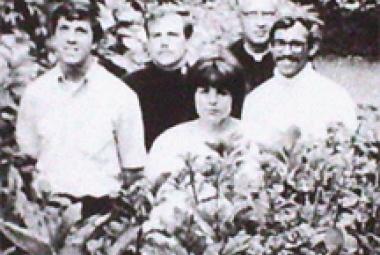“(I Can’t Get No) Satisfaction” (or simply “Satisfaction”) is a song by the English rock band the Rolling Stones, released in 1965. It was written by Mick Jagger and Keith Richards and produced by Andrew Loog Oldham. Richards’ three-note guitar riff — intended to be replaced by horns — opens and drives the song. The lyrics refer to sexual frustration and commercialism. The song was first released as a single in the United States in June 1965 and was also featured on the American version of the Rolling Stones’ fourth studio album, Out of Our Heads, released that July. “Satisfaction” was a hit, giving the Stones their first number one in the US. In 2004, Rolling Stone magazine placed “(I Can’t Get No) Satisfaction” in the second spot on its list of “The 500 Greatest Songs of All Time”. The song was added to the National Recording Registry of the Library of Congress in 2006. (More from Wikipedia)
See Also:● (I Can’t Get No) Satisfaction
● Satisfaction
● Satisfaction, (I Can’t Get No)
“(I Can’t Get No) Satisfaction” was the Rolling Stones’ first #1 hit in America; and believe it or not, that did not happen until the Stones had released some 12 or 15 previous singles over nearly a two-year period. Their previous Top 10 hits were “Time Is on My Side” and “The Last Time”. “Satisfaction” was released in the US 50 years ago, in June 1965. After that, there was no stopping them.
I had heard from several people that “Satisfaction” had dirty lyrics; we’d heard the same rumors about “Louie Louie”. The line that was mentioned to me (probably by a summer camp counselor) was: “I’m trying to make some girl” – I said, okay, but I didn’t actually know what that meant at the time.
There is a post discussing the meaning of “Satisfaction” on the website shmoop.com, and that makes reference to another line that I didn’t really understand at the time either (although I eventually decided that this must be what was meant): “The anti-commercial rant [in the early part of the song] rubbed some folks the wrong way, but [Mick] Jagger’s blunt recapitulation of his failed attempts to ‘make some girl’ was the real problem. Radio stations hesitated to play the song. Funnily enough, they were actually hung up on one of its tamer lines. When the Stones appeared on Shindig, a variety TV show, standards-sensitive execs bleeped ‘And I’m tryin’ to make some girl’. Meanwhile, the reference to a woman being on her period – ‘better come back later next week, ’cause you see I’m on a losing streak’ – made it on air with no problems at all.”
* * *
The same post about “Satisfaction” on shmoop.com also notes: “Richards claims to have heard the [song’s opening] notes in a dream, as a dead-asleep epiphany in a Florida hotel. Of course, this is Keith Richards we’re talking about — the distinctions between awake and asleep, day and night, are a bit sketchy for the hard-living rocker. But whatever nocturnal state he was in, Richards was wise enough to record the historic riff on a cassette player before slipping back into it. And the tape with the rock-changing riff (and about forty minutes of snoring) was enough to give Richards and his songwriting partner Mick Jagger a rolling start in the studio.”
The guitar was run through a new toy that Keith Richards had purchased, a Gibson Maestro fuzzbox; the intention by Mick and Keith was to replace the guitar with horns. But according to Wikipedia, they were outvoted by the other members of the Rolling Stones, as well as their manager Andrew Loog Oldham and sound engineer Dave Hassinger; and the song was released as it was. As a result, Gibson sold completely out of fuzzboxes by the end of the year, and the fuzzbox sound became an integral part of the sound of the 1960’s.
Initially I did not recognize the introductory music on the song as being played on a guitar; I thought that must be a saxophone. That got some undeserved laughter thrown my way, as I remember it. But I have to admit I had no clue that a fuzzbox was involved until just a few years ago.
* * *
I found another great Keith Richards quote on SongFacts concerning “The Last Time” – the 45 that was released right before “Satisfaction” – as taken from the 2003 book According to the Rolling Stones: “We didn’t find it difficult to write pop songs, but it was VERY difficult – and I think Mick [Jagger] will agree – to write one for the Stones. It seemed to us it took months and months and in the end we came up with ‘The Last Time’, which was basically re-adapting a traditional Gospel song that had been sung by the Staple Singers, but luckily the song itself goes back into the mists of time. I think I was trying to learn it on the guitar just to get the chords, sitting there playing along with the record, no gigs, nothing else to do. At least we put our own stamp on it, as the Staple Singers had done, and as many other people have before and since: they’re still singing it in churches today. It gave us something to build on to create the first song that we felt we could decently present to the band to play. . . . ‘The Last Time’ was kind of a bridge into thinking about writing for the Stones. It gave us a level of confidence; a pathway of how to do it. And once we had done that, we were in the game. There was no mercy, because then we had to come up with the next one. We had entered a race without even knowing it.”















